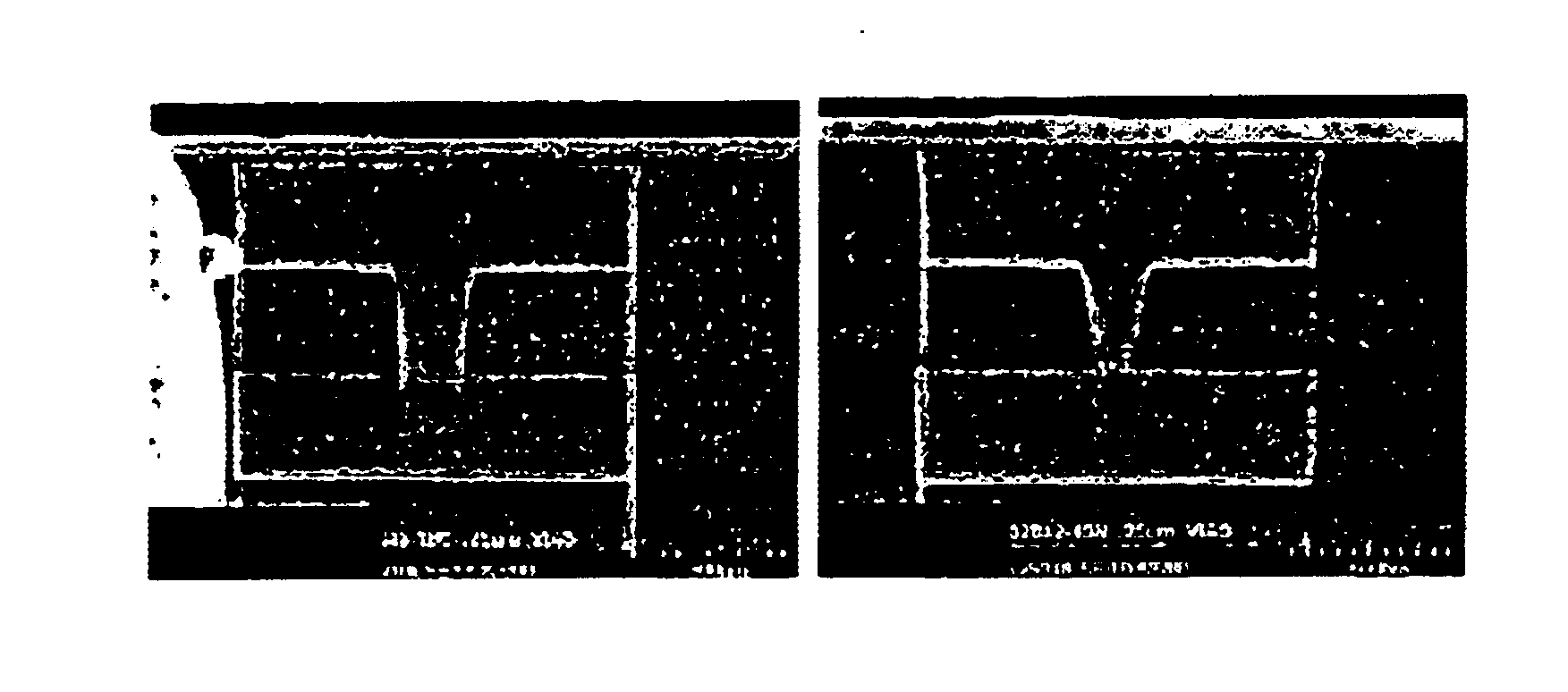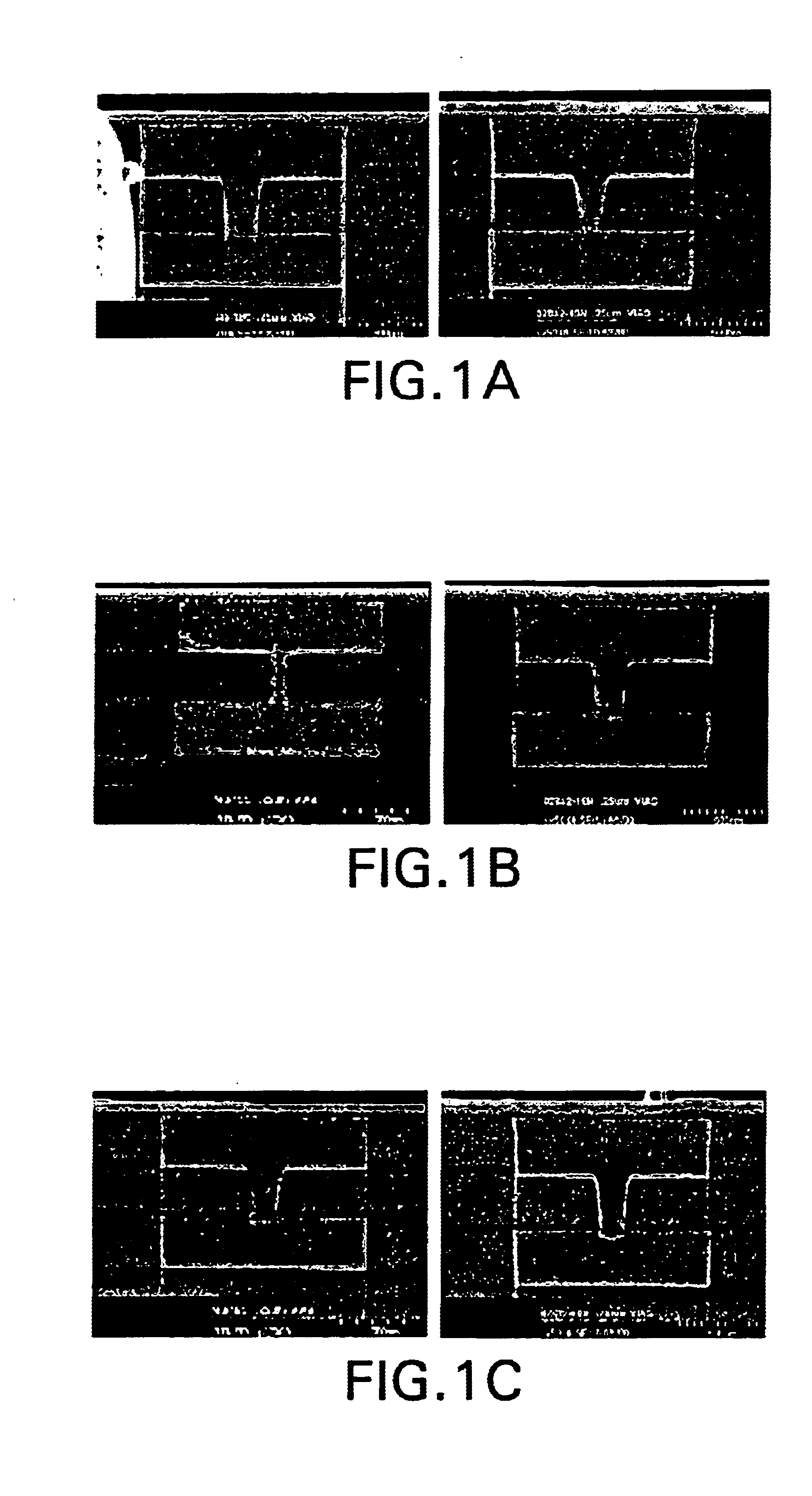Sulfoxide pyrolid(in)one alkanolamine cleaner composition
a technology of alkanolamine and sulfoxide pyrolid, which is applied in the direction of detergent compounding agents, instruments, photomechanical equipment, etc., can solve the problems of insufficient removal effect of polyimide layer by many conventional strippers, no single cleaner is universal, and ineffective removal effect of many conventional strippers
- Summary
- Abstract
- Description
- Claims
- Application Information
AI Technical Summary
Benefits of technology
Problems solved by technology
Method used
Image
Examples
examples
[0101]The following abbreviations may be used in the examples:[0102]TBPH=tetrabutyl phosphonium hydroxide;[0103]DCH=dicarbethoxy hydrazine;[0104]TMAF=tetramethylammonium formate;[0105]MEA=monoethanolamine, Ethanolamine, 2-Aminoethanol; [141-43-5];[0106]NMP=N-methyl pyrrolidone;[0107]PG=propylene glycol;[0108]PC=propylene carbonate;[0109]HDA®=hydroxylamine;[0110]DEHA=diethylhydroxylamine;[0111]MIPA=monoisopropanolamine;[0112]DMPD=1,3- and 1,5-Dimethyl-2-piperidone, [1690-76-2] and [86917-58-0], a mixture;[0113]Gamma-BLO=4-Hydroxybutyric acid gamma-lactone, gamma-Butyrolactone, [96-48-0];[0114]MMEA=2-(Methylamino)ethanol, Monomethylethanolamine; [109-83-1];[0115]DEA=Diethanolamine, 2,2′-Imin6diethanol; [111-42-2];[0116]DGA=Diglycolamine, Diethylene glycolamine, 2-(2-Aminoethoxy)ethanol; [929-06-6];[0117]RT=Room temperature, i.e., approximately 20-25° C.
[0118]The following photoresists were tested:[0119](1) Shipley 510™ positive resist, 1.5 micron thickness, soft-baked and hard-baked;[...
examples 1-48
[0124]Numerous compositions of the present invention were tested for etching of copper. CuSMTK (Cu, EP / Sematech) wafers were tested with the compositions by immersion at 70° C. for 30 mins. rotating at 200 rpm, followed by a deionized water rinse for 3-5 minutes and drying under nitrogen. The composition of the tested examples is provided in Table 1. The following results, in Table 2, were obtained by a 4-point test, where etch rate is given in Å / minute and the visual inspection is on a scale of 10 (no sign of etching) to 0 (unacceptable etching).
[0125]
TABLE 1Composition of Examples 1-481.NMP (45%)γ-BLO (15%)Morpholine (15%)TEA[triethanolamine] (25%)2.NMP (45%)γ-BLO (15%)DEA[Diethanolamine] (40%)3.NMP (45%)γ-BLO (15%)DEA (20%)TEA (20%)4.NMP (45%)γ-BLO (15%)DGA (40%)5.NMP (45%)γ-BLO (15%)DGA (20%)TEA (20%)6.NMP (65%)γ-BLO (23%)MEA (12%)7.NMP (64%)γ-BLO (18%)MEA (18%)8.NMP (70%)γ-BLO (22%)piperazine (8%)9.NMP (72%)γ-BLO (16%)piperazine (12%)10.NMP (72%)γ-BLO (10%)DEA (18%)11.NMP (72%)...
example 49
[0129]Selected low-K substrates were tested with a composition containing 35% DMSO, 20% NMP, and 45% DEA (the composition of Example 43) by immersion at 70° C. for 30 min rotating at 200 rpm, followed by a deionized water (DIW) rinse for 3-5 minutes and drying under nitrogen. The following results were obtained by an ellipsometer.
[0130]
Refractive IndexSubstrateEtch rate {Å / min}ChangeIR SpectraHSQ−0.20OKHOSP ™+2.2+0.017OKSiLK ™+5.9−0.004OKCoral ™+3.9−0.008OKSiOC−2.1+0.027OKNanoglass ™+0.8+0.011OKTEOS+1.5−0.006OK+: Indicates increase; −: Indicate decreases.
[0131]This data shows this composition is useful for removing photoresists from these low-K materials without causing significant, i.e., greater than about 10 Å per minute, etching of the materials.
PUM
| Property | Measurement | Unit |
|---|---|---|
| Temperature | aaaaa | aaaaa |
| Temperature | aaaaa | aaaaa |
| Temperature | aaaaa | aaaaa |
Abstract
Description
Claims
Application Information
 Login to View More
Login to View More - R&D
- Intellectual Property
- Life Sciences
- Materials
- Tech Scout
- Unparalleled Data Quality
- Higher Quality Content
- 60% Fewer Hallucinations
Browse by: Latest US Patents, China's latest patents, Technical Efficacy Thesaurus, Application Domain, Technology Topic, Popular Technical Reports.
© 2025 PatSnap. All rights reserved.Legal|Privacy policy|Modern Slavery Act Transparency Statement|Sitemap|About US| Contact US: help@patsnap.com



